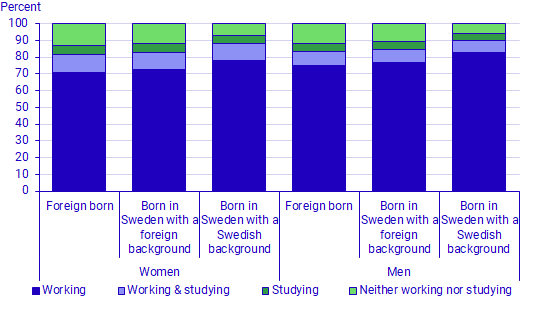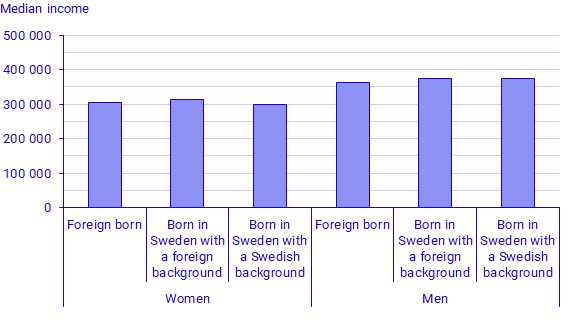Similar incomes 10 years after graduation regardless of national background
Statistical news from Statistics Sweden 2021-11-10 9.30
It is less common for foreign born pupils and pupils born in Sweden with a foreign background to complete upper secondary school with a school leaving certificate; they also have lower final school grades on average than pupils born in Sweden with a Swedish background. Among those with a school leaving certificate, 10 years after upper secondary school a lower percentage of these groups are in work. However, among those with a school leaving certificate who are in work, incomes are on average roughly the same regardless of national background, according to this year’s report on integration.
The report Integration – final school grades, further studies, and the labour market describes young people with different national backgrounds, but with similar opportunities in terms of types of programme and grade levels in upper secondary school.
Some key results include:
- Among persons with a foreign background, there is a higher percentage of persons who are neither working nor studying 10 years after upper secondary school. This percentage is also higher among those with lower grades. Furthermore, the percentage of pupils with lower grades is higher among pupils with a foreign background than among pupils with a Swedish background.
- Ten years after upper secondary school, the median income among those in work is roughly the same regardless of national background. However, there are clear differences between women and men. The median income rises with higher grades from upper secondary school.
- The percentage of those who enrol in further studies after upper secondary school is higher among foreign born persons than among persons born in Sweden with a Swedish background, particularly among those with low final school grades. On the other hand, differences between national backgrounds are minor when it comes to the percentage of people with a post-secondary education degree.
- Many foreign born persons do not complete upper secondary school or immigrate as adults. The percentage of those in work is lower among both these groups. Those in work have an income roughly on a par with the groups with the lowest grade levels.
Higher percentage among those with a foreign background neither working nor studying 10 years after upper secondary school
Regardless of national background, working is the most common activity ten years after upper secondary school. The percentage of those in work who are not studying at the same time is lower among foreign born persons and persons born in Sweden with a foreign background than among those with a Swedish background, while the percentage who are neither working nor studying is higher. In terms of employment, the differences are minor between foreign born persons and persons born in Sweden with a foreign background.
The percentage of those who are neither working nor studying is higher in groups with lower grades. This percentage is often at least twice as high in the group with the lowest grades compared with the group with the highest grades. Regardless of grade level, there are clear differences in the percentage of those neither working nor studying based on national background.
School leavers from upper secondary school 1998–2009

Similar incomes regardless of national background
Ten years after upper secondary school, the median income among those in work is roughly the same regardless of national background. However, there are clear differences between women and men. The median income rises with pupils’ higher final school grades. Incomes are also higher among those who attended higher education preparatory programmes than among those who attended vocational programmes.
In a comparison of income between different grade levels and types of programme, those with a foreign background often have higher incomes than those with a Swedish background. This applies primarily to women who attended higher education preparatory programmes and those with the highest grades. However, since persons with a foreign background are over-represented among those with lower grades, overall this group has the same incomes as those with a Swedish background.
School leavers from upper secondary school 1998–2009

Total earned income is defined as the sum of all taxable income before taxes. This includes income from wage or salary and income from active business, as well as income such as sickness benefit, parental allowance, and unemployment benefits.
Educational choices during and after upper secondary school affect incomes
In general, people with a post-secondary educational attainment have higher incomes than those with an upper secondary educational attainment. The percentage of those who enrol in further studies is higher among foreign born persons than among persons born in Sweden with a Swedish background, particularly among those with lower final school grades. On the other hand, differences between national backgrounds are minor when it comes to the percentage of people with a post-secondary education degree.
There are also some differences based on national background in terms of field of education, both at upper secondary level and in post-secondary education. Attending the health care programme at upper secondary school, for example, is much more common among foreign born persons compared with other groups, and foreign born persons are also somewhat over-represented in programmes in health and medical care and social care at the post-secondary level, such as in the medical programme. Within these programmes, incomes are higher for foreign born persons and persons born in Sweden with a foreign background.
It is more common for foreign born persons and persons born in Sweden with a foreign background to start studies at higher education institutions directly after upper secondary school, while those with a Swedish background more often wait one or more years before further studies. This means that those with a foreign background may complete their studies sooner. More years of work experience may lead to a higher income than among those with a Swedish background.
Many foreign born persons do not complete upper secondary school or immigrate as adults
The percentage of those with a school leaving certificate from upper secondary school varies widely between young people with different national backgrounds. There are also differences in terms of the percentage of people who complete upper secondary school with a school leaving certificate among those who commence upper secondary school. Furthermore, among foreign born persons, many immigrated as adults and thereby did not attend upper secondary school in Sweden. The proportion of 29-year olds in work is considerably smaller among foreign born persons who immigrated as adults compared with other groups. In addition, those who do not have a leaving certificate are less likely to be in work, compared with those who have a leaving certificate. Those who immigrated as adults or who completed upper secondary school without a leaving certificate and who are in work have incomes roughly on a par with the groups with the lowest grade level.
Definitions and explanations
In the report, we follow people who completed upper secondary school with a school leaving certificate between 1998–2009 for a ten-year period, that is, up to and including at most 2019. The report includes a chapter in which the analysis is broadened to include those who left upper secondary school without a school leaving certificate and those who immigrated to Sweden as adults.
National background is broken down into three groups:
- Foreign born persons: this refers to people who were born abroad. No account is taken of where their parents were born.
- Persons born in Sweden with a foreign background: this refers to people who were born in Sweden whose both parents were born abroad.
- Persons born in Sweden with a Swedish background: this refers to people who were born in Sweden and who have at least one parent also born in Sweden.
School leavers from upper secondary school:
Those who complete upper secondary school with a school leaving certificate, also referred to as “school leavers”. In addition to those with a leaving certificate with goal and knowledge-related course grades, this group also includes those who completed an upper secondary education at a Waldorf school and those who received a diploma from the International Baccalaureate programme.
Employment is broken down into four categories:
- Employed
Gainfully employed according to the register-based labour market statistics (RAMS) and not registered as studying during the autumn term according to the register of students - Working and studying
Gainfully employed according to RAMS and registered as studying - Studying
Not gainfully employed according to RAMS and registered as studying - Neither working nor studying
Not gainfully employed according to RAMS and not registered as studying
Total earned income:
Total earned income is defined as the sum of all taxable income before taxes. This includes income from wage or salary and income from active business, as well as income such as sickness benefit, parental allowance, and unemployment benefits. The income is affected by the wage or salary, but also by whether the person works full-time or part-time and whether they have been on parental leave, sick, or unemployed during the year. Incomes have been adjusted to the 2020 level with the Consumer Price Index (CPI).
Publication
Integration – final school grades, further studies, and the labour market (summary in English)
Feel free to use the facts from this statistical news but remember to state Source: Statistics Sweden.
